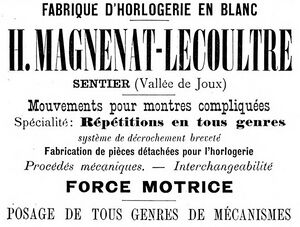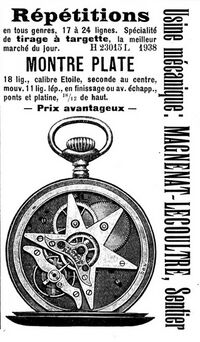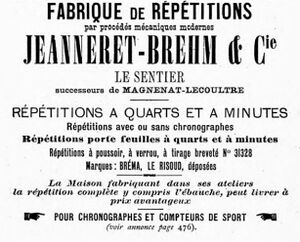Magnenat-LeCoultre

H. Magnenat-LeCoultre was a maker of complicated watch movements, notably repeaters, in Le Sentier from 1897 through 1917. It was acquired by Jeanneret-Brehm (Excelsior Park) of Saint-Imier in 1910.
Founding by Henri Magnenat

H. Magnenat-LeCoultre specialized in complicated watches, notably repeaters. The firm of Magnenat-LeCoultre traces its origins to 1887, when Henri-Gabriel Magnenat-LeCoultre founded a watchmaking workshop in Le Sentier. The son of François Magnenat, Henri Gabriel came from Vaulion but lived in the area called Derrière-la-Côte near Le Sentier.
The factory specialized in raw movements for complicated watches, focusing on repeaters specifically. The company boasted of its patented hammer mechanism for chiming watches along with the powered machines used. By 1898 the focus shifted to production of complete watches in gold or silver cases and chronograph repeaters, though the firm still offered raw movements. The workshop also had an early telephone line by this time.
In 1901, H. Magnenat-LeCoultre registered the brand name "Le Risoud" with a logo featuring two pine trees to represent the forest (also called Le Risoux) in the Vallée de Joux. The company also offered automatons and simple time-only movements at this point, and had selected Léon Droz as its representative in La Chaux-de-Fonds.

The firm was reorganized as a limited partnership called H. Magnenat-LeCoultre et Cie on October 1, 1902. The new company was headed by Henri Magnenat-LeCoultre as unlimited partner, along with eight investors: Two sons of Eugène Piguet John and Charles-Henri Piguet, Louis Droz, son of Charles-Frederic, Henri Moret, son of Jules, Eugène-Samuel Aubert, son of Eugène, Paul-Olivier Magnenat, son of Francois, Paul-Alfred Guignard, son of Alfred, Louis-Samuel Meylan, son of Charles, each of whom bought in for 1,000 francs.
Through the first decade of the 20th century the company boasted of a new 18 ligne ultra-flat movement with a star-shaped bridge. It also produced movements as small as 11 ligne and large 19 and 24 ligne repeaters, some with chronograph. There was also a 17 ligne quarter and minute repeater with a silent cog. The Le Risoud brand was used on an 18 ligne quarter and 5-minute repeater Lépine movement. The firm focused only on repeaters as of 1904, boasting of being the largest focused manufacturer. In 1905 the company introduced a cheaper 19 ligne minute repeater which did away with the lock and the pusher.
The limited partnership H. Magnenat-LeCoultre et Cie was replaced by a simple company called H. Magnenat-LeCoultre in January 1908. Henri-Gabriel Magnenat remained in charge.
Acquisition by Jeanneret-Brehm

- See Also: Jeanneret-Brehm
On January 1, 1910, H. Magnenat-LeCoultre was taken over by Jeanneret-Brehm & Cie of Saint-Imier. Later known as Excelsior Park, the firm wanted to expand production outside Saint-Imier to meet demand. Henri Magnenat-LeCoultre joined management of the firm and became a limited partner at 7,000 francs, though the Jeanneret family was firmly in charge. The Le Sentier operation was henceforth known as Jeanueret-Brehm & Cie, Fabrique Le Risoud.
Under Jeanneret-Brehm the Le Sentier factory continued to focus on repeaters even as these fell from favor due to the war and the advent of luminous radium dials. The company continued the Le Risoud watch and also used the Bréma brand, perhaps a reference to the alliance name of the new manager.
In March of 1917 Jeanneret-Brehm decided to close the factory in Le Sentier, merging it with the parent company in Saint-Imier.